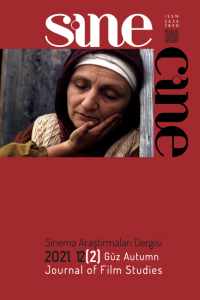AVRUPA İLE ORTAK-YAPIM TÜRKİYE FİLMLERİ: EURIMAGES VE YİRMİ YILIN HİKAYESİ
1990 sonrası dönemde Türk sinemasına parasal destek sağlayan dört yeni kaynak ortaya çıkmıştır. Bunlar içinde Avrupa Konseyi sinema fonu Eurimages, destek kararlarının üye ülke temsilcileri tarafından alındığı, ulusal olmayan tek oluşumdur. Bu makale, yirmi yıllık üyeliğin ardından, ancak bir dizi kriteri karşılayan projelere destek veren uluslarüstü bu fonun ulusal bir sinemaya etkilerini/katkılarını Türkiye sineması özelinde ortaya koymayı amaçlamaktadır. Özellikle Eurimages destekli Türkiye filmlerinin ulusallığı veya Avrupalılığı tartışması, Türk yapımcıların ortak yapımcı seçiminde öncelik verdikleri ülkeler ve bunun arkasında yatan nedenler ile Eurimages yapım desteğinin Türkiye’deki sinemasal üretime katkıları ele alınmaktadır. Bu makalede, üzerine yazılanların çok sınırlı olduğu bu yeni olguya ilişkin analizler üç kaynağa dayanmaktadır. Bunlar, bugüne kadar Eurimages tarafından desteklenmiş olan Türk filmleri; sürecin gözlemcisi veya tarafı olmuş yapımcı-sinemacılar, geçmişteki ve mevcut Eurimages yetkilileri ile Türkiye’nin fondaki temsilcileri gibi profesyonellerle gerek yazar tarafından yapılan gerekse de dergilerde yayınlanmış röportajlar ve resmi Eurimages dokümanlarıdır. Önce fonun tanımı ve amaçları, ardından deneyimlenen sürecin sonuçları fon tarafından desteklenmiş Türk filmleri özelinde ortaya konmakta ve eleştirilere yer verilmektedir.
Anahtar Kelimeler:
Eurimages, Avrupa Konseyi, Türk sineması, ortak yapım, destek, ulusal, fon, Türkiye
TURKISH FILMS CO-PRODUCED WITHIN EUROPE: THE STORY AFTER TWENTY YEARS’ EXPERIENCE IN EURIMAGES
Out of four new sources of financial support for Turkish cinema that emerged in the post-1990 period, Eurimages, the cinema support fund of Council of Europe, is the only non-domestic one where decisions are taken with the agreement of the national representatives of the member states. Considering the experience of twenty years left behind in Turkey’s membership to Eurimages, this article examines the influences/ contributions of a supranational cinema support fund – which demands a series of criteria to be met - on a national cinema. The focus is particularly on the nationalness and/or Europeanness of Eurimages-backed Turkish initiative films in terms of both style and content; co-producer country preferences of Turkish producers; and the contributions of Eurimages support to filmmaking practices in Turkey. As written materials on this quite new phenomenon are limited in number, the analyses are primarily attained through a study of the films, interviews with the professionals (those made by the author and some cited from the media as well) who have first hand experience of the process, and official documents of Eurimages. Following the definition and objectives of the Fund, various conclusions out of the lived experience and criticisms are put forth.
Keywords:
Eurimages, Council of Europe Turkish, film, cinema, co-production, support, national, fund, Turkey,
___
- Box Office. (n.d.). Antrakt Sinema Gazetesi.Retrieved from http://www.antraktsinema.com/ boxoffice.php
- Deleuze, G. (2003). Cinema 2: The Time Image (7th ed.). (H. Tomlinson & R. Galeta, Trans.). Minneapolis: University of Minnesota Press.
- Erdine, S. (2003). Çamur Çek, İzi Kalsın! [Shoot the Mud, Leave the Trace!]. Sinema, 102, 68-71.
- Eurimages. (n.d.). Mission and Objectives. Retrieved from http://www.coe.int/t/dg4/ eurimages/About/default_en.asp
- Eurimages. Co-production Funding History. Retrieved from http://www.coe.int/t/dg4/ eurimages/History/Coproduction/default_en.asp
- Finney, A. (1996). The State of European Cinema: A New Dose of Reality. London: Cassell.
- Karakaya, S. (2002). Doksanlı Yıllarda Türk Sinemasındaki Değişim: Arayış Sineması ve Popüler Sinema Karşıtlığı ve Eurimages Etkileri [The Transformation in the Turkish cinema art in 1990s: The convergence of the new cinema phenomena and popular cinema and the Effects of Eurimages] (Doctoral dissertation). İstanbul Üniversitesi Sosyal Bilimler Enstitüsü, İstanbul.
- Özcan, E. (2005). Barış Pirhasan’la Avrupa Sineması ve Eurimages Üzerine [Interview with Barış Pirhasan on European Cinema and Eurimages]. Toplumbilim, 18, 187-190.
- Özcan, E. (2005). Eurimages ve Türkiye: Genel Bir Bakış [Eurimages and Turkey: A General Overview]. Toplumbilim, 18, 183-186.
- Peker, B. (1992). Yaratıcıları ‘Robert’in Filmi’ni Anlatıyor [Its Creators Talk About the ‘Robert’s Movie’]. Hürriyet Gösteri, 136, 64-67.
- Pisters, P. (2006). Arresting the Flux of Images and Sounds: Free Indirect Discourse and the Dialectics of Political Cinema. In I. Buchanan & A. Parr (Eds.), Deleuze Connections: Deleuze and the Contemporary World (pp. 175-193). Edinburgh: Edinburgh University Press.
- Refiğ, H. (1971). Ulusal Sinema Kavgası [Fight for National Cinema]. Istanbul: Hareket. Sinematurk 2.0: Sinepedya. (n.d.) Sinematürk. Retrieved from http://www.sinematurk.com Soydan, M. (2008). Postyapısalcı Bir Okumayla Eurimages Destekli Türk Filmlerinin Çözümlenmesi [Analysis of Turkish movies supported by Eurimages with a poststructural reading] (Doctoral dissertation). Ege Üniversitesi Sosyal Bilimler Enstitüsü, Izmir.
- Tankuter, K. (1994). Amerikan Tekeli ve Türk Sineması [American Monopoly and Turkish Cinema]. Milliyet Sanat, 344, 26-29.
- Uzer, N. (1997). Kuşatma Altında Aşk: Yönetmen Ersin Pertan’la Yeni Filmi Üzerine [Lover under Siege: Interview with the Director Ersin Pertan on his Recent Film]. Sinema, 35, 94-97.
- Yurdatap, K. & Yavuz, D. (2004). Türkiye Sinema Sektörünün Görünümü [Analysis of the Turkish Film Industry]. İstanbul: SESAM-Türkiye Sinema Eseri Sahipleri Meslek Birliği.
- ISSN: 2636-784X
- Yayın Aralığı: Yıllık
- Başlangıç: 2010
- Yayıncı: Semire Ruken Öztürk
Sayıdaki Diğer Makaleler
AVRUPA İLE ORTAK-YAPIM TÜRKİYE FİLMLERİ: EURIMAGES VE YİRMİ YILIN HİKAYESİ
Bilge Olgaç'ın Gülüşan Filmi İçin Bir Okuma Denemesi
AZINLIK FİLMLERİ: TARİHİN YENİDEN İNŞASI VE KOLEKTİF BELLEK
Bellek Olarak Belgesel Sinema: Son Dönem Türkiye Belgesel Sinemasına Bir Bakış
Kadın Gözünden Akdeniz Sineması
Bilge Olgaç'ın Gülüşan Filmi İçin Bir Okuma Denemesi
THE HURT LOCKER: ERİL YAKINLIK, ŞİDDET VE IRAK SAVAŞ FİLMİ
SİNEMA YA DA İLAHİ AŞK: İSLAMİ SİNEMADA TASAVVUFİ YOLCULUKLAR
